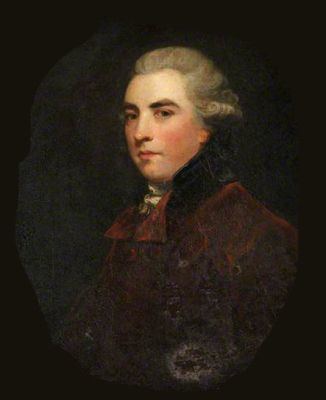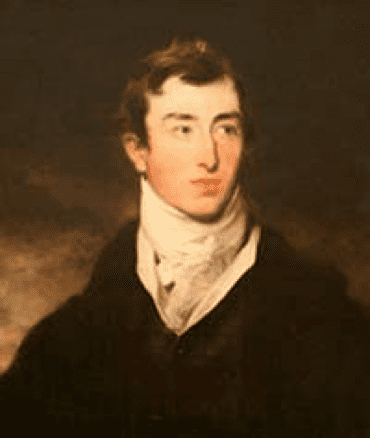Name John 3rd Role Cricket Player | Parents Lord John Sackville | |
 | ||
Died July 19, 1799, Sevenoaks, United Kingdom | ||
John Frederick Sackville, 3rd Duke of Dorset, KG (24 March 1745 – 19 July 1799) was the only son of Lord John Philip Sackville, second son of Lionel Sackville, 1st Duke of Dorset. He succeeded to the dukedom in 1769 on the death of his uncle, Charles Sackville, 2nd Duke of Dorset. He was the British Ambassador to France between 1783 and 1789 in the lead up to the French Revolution.
Contents

He is best remembered for his love of cricket. He was both a good player and an important patron, but his interest was sharpened by gambling, cricket being a major attraction for gamblers throughout the 18th century. His other sporting interests included billiards and tennis, while he acquired a reputation as a womaniser.
Politics
He was returned unopposed as the Member of Parliament for the county of Kent in 1768, sitting until he became the 3rd Duke of Dorset on the death of his uncle in 1769.
He was appointed Lord Lieutenant of Kent in 1769, a position he held until 1797. He was Captain of the Yeomen of the Guard from 1789 until his death.
Cricket
The young John Sackville was schooled at Westminster, where he first became a noted proponent of cricket. He went on to join Hambledon Cricket Club, based in Hambledon, Hampshire, which was the leading cricket club of the day. He was joined there by Sir Horatio Mann, a Carthusian, and Lord Tankerville of Eton and Surrey, who was his keenest rival.
Dorset gained a reputation as a keen competitor. The Morning Post in 1773 wrote: "The Duke...having run a considerable number of notches from off strokes, the opposing fielders very unpolitely swarmed round his bat so close as to impede his making a full stroke; his Grace gently expostulated with them on this unfair mode, and pointed out their danger, which having no effect, he, with proper spirit made full play at a ball and in so doing brought one of the gentlemen to the ground".
In the same year, Dorset presented the Vine Cricket Ground, at Knole, Sevenoaks, Kent, to the town, at a peppercorn rent, literally. It is one of the oldest cricket grounds in England. The first nationally reported cricket match had taken place here in the 1734 season when "The Gentlemen of Kent" beat "The Gentlemen of Sussex". Sevenoaks Town Council still has the Vine Cricket Club, though the rent doubled to two peppercorns after the pavilion was built in the 19th century. They must also pay the Lord Sackville (if asked) one cricket ball on 21 July each year.
In 1775, a full-scale riot broke out at the Artillery Ground when Dorset's side was not performing too well. In 1782 the Morning Chronicle noted that "His Grace is one of the few noblemen who endeavour to combine the elegance of modern luxury with the more manly sports of the old English times".
Dorset's patronage of cricket was expensive — the Whitehall Evening Post in 1783 noted that the cost to Dorset of maintaining his team, before bets, was £1,000 a year. This was a lot, but less than the amounts some of his contemporaries were spending on racing. The report went to say that Dorset was unrivalled (among noblemen) "at cricket, tennis and billiards".
Ambassador to France
In 1784 Dorset moved to Paris, surprising his critics with newfound public dedication, to serve as ambassador to France. On 16 July 1789, two days after the Storming of the Bastille he reported to Secretary of State for Foreign Affairs Francis Osborne, 5th Duke of Leeds, "Thus, my Lord, the greatest revolution that we know anything of has been effected with, comparatively speaking—if the magnitude of the event is considered—the loss of very few lives. From this moment we may consider France as a free country, the King a very limited monarch, and the nobility as reduced to a level with the rest of the nation."
He continued to promote cricket amongst the locals and British expatriates. In 1786 The Times reported on a cricket match played by some English gentlemen in the Champs-Elysées:
His Grace of Dorset was, as usual, the most distinguished for skill and activity. The French, however, cannot imitate us in such vigorous exertions of the body, so that we seldom see them enter the lists.The following year The Times noted that horse-racing was losing popularity in France, with cricket, on Dorset's recommendation, taking its place. In 1789 Dorset planned what might have become the first international cricket tour. His touring side, which included William Yalden, William Bedster and Lumpy Stevens, got as far as congregating on 10 August at Dover. But the French Revolution meant that they never got to France, thereby making his tour the first international cricket tour to be cancelled for political reasons. Just as the American Civil War 80 or so years later destroyed the prospect of cricket becoming popular there, so the French Revolution destroyed any footholds the game had in France.
Back in England, Dorset became one of the first members of the Marylebone Cricket Club; his public life continued in the post of Steward of the Royal Household — in which capacity his main role was to keep an eye on the dissolute Prince of Wales, the future George IV.
Personal life
Dorset was a notorious womanizer. Augustus FitzRoy, 3rd Duke of Grafton became Prime Minister and his mistress Anne Parsons had the influence, if not the position, of a First Lady in her country. The Duke divorced his wife on the 23 March 1769. Parsons may have become the First Minister's wife had he not discovered that Parsons was having an affair with Sackville.
Sackville's best-known and most enduring mistress was the Venetian ballerina Giovanna Zanerini, who was the principal ballerina at the King's Theatre, Haymarket, and used the stage name Giovanna Baccelli. Dorset commissioned a painting of her in 1780–81 from Thomas Gainsborough, which is reckoned to be one of Gainsborough's later masterpieces. He also commissioned a painting by Joshua Reynolds and a sculpture showing her nude and prone on a divan and cushions; this is still to be found at Knole. When made Ambassador to France, Dorset even took her to Paris with him, and she danced at the Opera by invitation. (When he was made Knight of the Garter (KG), she wore the blue ribbon of the Garter while dancing) Dorset and Giovanna had a son together: John Frederick Sackville (1778–1796), who was raised by his father at Paris and Knole after the couple parted in 1789.
The Duke was also known for his affair (ca. 1777–1779) with the Countess of Derby, and briefly (ca. 1784) with Lady Elizabeth Foster, daughter of Frederick Hervey, 4th Earl of Bristol and mistress of William Cavendish, 5th Duke of Devonshire. The first affair was notable because it did not lead to a divorce. The Countess of Derby was born Lady Elizabeth Hamilton, the only daughter of the 6th Duke of Hamilton and the beauty Elizabeth Gunning. However, the Earl of Derby refused to divorce his errant wife. This meant that Lady Derby was ostracized for the remainder of her life, and Dorset soon lost interest and abandoned his lover. He was received back into society, and even received by his former mistress's betrayed husband Lord Derby.
Marriage and descendants
In 1790, after returning from France, Dorset married twenty-three-year-old Arabella Diana Cope (1767-1825), daughter and co-heiress of Sir Charles Cope, 2nd Baronet, and stepdaughter of Charles Jenkinson, 1st Earl of Liverpool. They had one son together, George John Frederick, who was born on 15 November 1793, and two daughters, Lady Mary Sackville, born on 30 July 1792, and Lady Elizabeth Sackville, born on 11 August 1795. The Duke died 1799, aged 54, and left a life interest in his estates and free disposition thereof (in case of the death of their son) to his wife Arabella Diana. At his death, Arabella, Duchess of Dorset was thus a very wealthy heiress. (She remarried 1801 Charles Whitworth, who became 1st Earl of Whitworth, but had no further issue). From 1799 until her death in 1825, Arabella Duchess of Dorset (as she preferred to be known) controlled the Sackville estates and wealth; at her death, Knole went to her elder daughter the Countess of Plymouth, and Buckhurst and the Middlesex lands (of the Cranfield family) went to her younger daughter the Countess De La Warr.
Lady Mary Sackville married firstly Other Windsor, 6th Earl of Plymouth (1789-1833) on 5 August 1811 and secondly her first husband's stepfather William Amherst, 1st Earl Amherst on 25 May 1839. She died childless on 20 July 1864, leaving her estates to younger sons of her sister and their heirs male, following the remainder of the barony Buckhurst.
George John Frederick became the 4th Duke of Dorset on his father's death at the family seat, Knole House, by Sevenoaks, Kent, in 1799 aged 6. He spent the rest of his life under the legal and financial control of his mother and stepfather. The 4th Duke died in a riding accident in Ireland, aged 21. At his death, he had just become engaged to Lady Elizabeth Thynne (b. 1795), elder daughter of Thomas Thynne, 2nd Marquess of Bath. (She went on to marry October 1816 Lord Cawdor and have many children).
Knole was then inherited after Duchess Arabella's death (1825) by his elder sister Mary, Countess of Plymouth, whose second husband William Amherst, 1st Earl Amherst died at Knole in 1857. She died childless in 1864, and the estate passed to the Countess De La Warr, who was created Baroness Buckhurst in her own right (a title later inherited by a younger son Reginald who is ancestor of the present Earl De La Warr). Another line stemming from this lady is that of the Barons Sackville, a title created in compensation for losing the Buckhurst title. The 1st Baron Sackville inherited Knole, according to the will of Mary, Countess of Plymouth. (He died unmarried, as did his brother the 2nd Baron). Their nephew, the 3rd Baron Sackville, was father of the writer Vita Sackville-West who created a garden at Sissinghurst. Knole House, still lived in by the Sackville-West family, and Sissinghurst, the family home of Lord Carnock have both been given to the National Trust.
